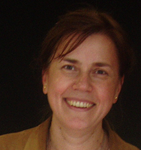Profile
Adina Michael-Titus was awarded a Doctorat en Sciences (France) in 1988, for studies on novel inhibitors of opioid peptide-degrading enzymes. She continued post-doctoral studies on opioid peptides, in Rouen and Paris until 1990, when she was offered the position of Lecturer in Physiology and Pharmacology in the School of Biological Sciences at Queen Mary. She became subsequently a Lecturer in Pharmacology at Barts and The London School of Medicine, and a Senior Lecturer in 2001. Between 2002 and 2004 she spent sabbatical research time as a Senior Scientist and Head of Section in Drug Discovery, with the pharmaceutical company Lundbeck A/S in Denmark. She became a Reader in 2007 and was awarded the title of Professor of Neuroscience in 2010. She is a Fellow of the British Pharmacological Society and is on the Board of Directors of the International Society for Studies on Fatty Acids and Lipids. She is also a Fellow of The Higher Education Academy.
Professor Adina Michael-Titus is the Lead of the Neurotrauma Group in the Centre for Neuroscience, Surgery and Trauma. She teaches neuroscience, pharmacology and therapeutics, and has a particular research interest in the characterization and development of novel therapeutic approaches in several neurological diseases. She is Programme Director of the MSc in Neuroscience and Translational Medicine, whose main aim is to help train the next generation of scientists and physicians involved in rapid and successful clinical translation of fundamental discoveries in neuroscience.
A large component of her present research programme is focused on neuroprotective agents in spinal cord injury and brain injury. Several of her present projects explore the remarkable therapeutic potential of natural compounds, such as the n-3 polyunsaturated fatty acids. Her group has also started a programme of studies on new therapeutic directions in neurodegeneration following injury. She is an inventor on several patents, a member of several scientific and professional societies and regularly acts as a reviewer for the UK research councils.
Teaching
Undergraduate and Post-graduate taught courses
- MBBS: Brain and Behaviour course (module convenor Year 2); SSC Year 2 and Year 4
- Graduate Entry Programme: Brain and Behaviour module
- Intercalated BSc Neuroscience (modules: Cell and Molecular Neuroscience; Disconnected Pathways; module convenor for Brain and Mind)
- Intercalated BMedSci (neuropharmacology)
- BSc (Hon) Neuroscience (module convenor: Perspectives in Brain Disorders)
- MSc Neuroscience and Translational Medicine (Programme Director and module convenor for Fundamentals of Drug Discovery and Development)
Research Students
General Topics for PhD supervision:
- New neuroprotective and neurorepair strategies in spinal cord injury and brain injury
- Biomarkers of neuronal injury and neurodegeneration
- Neurotrauma and brain ageing
- Neuroprotection of the immature brain
Research
Research Interests:
Neuroprotection; Neurorepair; Spinal cord injury; Brain injury; Biomarkers of injury.
Recent and ongoing research projects
- Development of fatty acid emulsions for use in acute neuroprotection in spinal cord injury
- Investigation of specialised medical multi-nutrients in neurotrauma
- New biomarkers of injury in the immature and adult brain
- White matter ageing
- Traumatic brain injury and senescence
PhD Students
- Lucas Baumard
- Rachel Ingram
- Zahra Falah Hassan Al-Khateeb
- Eleanor Sams
Publications
Key Publications
Thau-Zuchman O, Gomes RN, Dyall SC, Davies M, Priestley JV, Groenendijk M, De Wilde MC, Tremoleda JL, Michael-Titus AT. Brain Phospholipid Precursors Administered Post-Injury Reduce Tissue Damage and Improve Neurological Outcome in Experimental Traumatic Brain Injury. J Neurotrauma. 2018 Jul 25. doi: 10.1089/neu.2017.5579.
Yip PK, Carrillo-Jimenez A, King P, Vilalta A, Nomura K, Chau CC, Egerton AMS, Liu Z-H, Shetty AJ, Tremoleda JL, Davies M, Deierborg T, Priestley JV, Brown GC, Michael-Titus AT, Venero JL, Burguillos MA. Galectin-3 released in response to traumatic brain injury acts as an alarmin orchestrating brain immune response and promoting neurodegeneration. Sci Rep. 2017 Jan 27;7:41689. doi: 10.1038/srep41689.
Liu Z-H, Yip PK, Priestley JV, Michael-Titus AT. A Single Dose of Docosahexaenoic Acid Increases the Functional Recovery Promoted by Rehabilitation after Cervical Spinal Cord Injury in the Rat. J Neurotrauma 13 Jan 2017.
Pallier PN, Poddighe L, Zbarsky V, Kostusiak M, Choudhury R, Hart T, Burguillos MA, Musbahi O, Groenendijk M, Sijben JW, DeWilde MC, Quartu M, Priestley JV, Michael-Titus AT. A nutrient combination designed to enhance synapse formation and function improves outcome in experimental spinal cord injury. Neurobiol Dis 82:504-515 Oct 2015
Liu Z-H, Yip PK, Adams L, Davies M, Lee JW, Michael GJ, Priestley JV, Michael-Titus AT. A Single Bolus of Docosahexaenoic Acid Promotes Neuroplastic Changes in the Innervation of Spinal Cord Interneurons and Motor Neurons and Improves Functional Recovery after Spinal Cord Injury. J Neurosci 35(37):12733-12752 16 Sep 2015
All Publications
